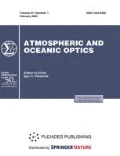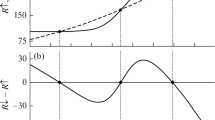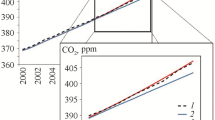Abstract
The optimal control problem for deliberate intervention in the Earth’s climate system with the aim of stabilizing the global surface temperature is considered. The deliberate action on the climate system is implemented via the controlled radiative disturbance created by artificial aerosols injected into the stratosphere. The controlled object is described by a two-component energy-balance model subject to radiative action caused by an increase in the concentration of greenhouse gases in the atmosphere. The human impact on the climate system is specified in accordance with Representative Concentration Pathway (RCP) scenarios, as well as with the scenario corresponding to a 1% increase in atmospheric carbon dioxide per year. The albedo of the artificial aerosol global layer represents the control variable. The optimal control and the corresponding phase trajectory of the climate system are obtained analytically using Pontryagin’s maximum principle. The approach discussed in this paper can be considered as a basis for developing scenarios for deliberate intervention in the climate system using various geoengineering methods.




Similar content being viewed by others
REFERENCES
Climate Change 2013: The physical science basis. Contribution of working group I to the Fifth Assessment Report of the Intergovernmental Panel on Climate Change (University Press, New York, Cambridge, 2013)
Statement on the State of the Global Climate in 2017, Report N 1212 (WMO, Geneva, Switzeland, 2018).
www.unfccc.int/sites/default/files/paris_agreement_english_.pdf (Cited June 1, 2018).
J. Rodelj, M. Elzen, N. Hohne, T. Fransen, H. Fekete, H. Winkler, R. Schaeffer, F. Sha, K. Riahi, and M. Meinshausen, “Paris Agreement climate proposals need a boost to keep warming well below 2°C,” Nature 534, 631–639. (2016).
P. Brown and K. Caldeira, “Greater future global warming inferred from Earth’s recent energy budget,” Nature 552, 45–50 (2017).
A. E. Raftery, A. Zimmer, D. M. W. Frierson, R. Startz, and P. Liu, “Less than 2°C warming by 2100 unlikely,” Nat. Clim. Change 7, 637–641 (2017).
D. Jacob, L. Kotova, C. Teichmann, S. P. Sobolowski, R. Vautard, C. Donnelly, A. G. Koutroulis, M. G. Grillakis, I. K. Tsanis, A. Damm, A. Sakalli, and M. T. H. van Vliet, “Climate impacts in Europe under +1.5 °C global warming,” Earth’s Future 6, 264–285 (2018).
K. Tanaka and B. C. O’Neill, “The Paris Agreement zero-emissions goal is not always consistent with the 1.5°C and 2°C temperature targets,” Nat. Clim. Change 8, 319–324 (2018).
B. Henley and A. King, “Trajectories toward the 1.5 °C Paris target: Modulation by the Interdecadal Pacific Oscillation,” Geophys. Res. Lett. 44, 4256–4262 (2017).
K. L. Ricke and D. W. Keith, “Solar geoengineering as part of an overall strategy for meeting the 1.5°C Paris target,” Phil. Trans. Roy. Soc., A 376, ID 20 160 454 (2018).
Climate Intervention Requires Enhanced Research, Consideration of Societal and Environmental Impacts, and Policy Development. https://sciencepolicy. agu.org/files/2018/01/Climate-Intervention-Position-Statement-Final-2018-1.pdf (Cited June 1, 2018).
AGU White Paper 2017: Climate Intervention Requires Enhanced Research, Consideration of Societal Impacts, and Policy Development. https://www.sciencepolicy. agu.org/files/2017/11/AGU-White-Paper-on-Geoengineeging.pdf (Cited June 1, 2018).
M. I. Budyko, “Technique for climate impact,” Meteorol. Gidrol., No. 2, 91–97 (1974).
Izrael' Yu.A., “An efficient way to regulate the global climate is the main objective of the solution of the climate problem,” Rus. Meteorol. Hydrol., No. 10, 1–4 (2005).
P. J. Crutzen, “Albedo enhancement by stratospheric sulfur injections: A contribution to resolve a policy dilemma?,” Clim. Change 77, 211–220 (2006).
A. S. Ginzburg, D. P. Gubanova, and V. M. Minashkin, “Impact of natural and anthropogenic aerosols on the global and regional climates,” Ros. Khim. Zh. LII (5), 112–119 (2008).
D. W. Keith, :Geoengineering the climate: History and prospect,” Annu. Rev. Energy Environ. 25, 245–284 (2000).
Yu. A. Izrael’, A. G. Ryaboshapko, and N. N. Petrov, “Comparative analysis of geo-engineering approaches to climate stabilization,” Rus. Meteorol. Hydrol., No. 6, 5–24 (2009).
A. Robock, A. Marquardt, B. Kravitz, and G. Stenchikov, “Benefits, risks, and costs of stratospheric geoengineering,” Geophys. Res. Lett. 36, L19703 (2009).
J. G. Shepherd, “Geoengineering the climate: An overview and update,” Phil. Trans. R. Soc. A 370, 4166–4175 (2009).
A. V. Chernokul’skii, A. V. Eliseev, and I. I. Mokhov, “Analytical estimations of the efficiency of climate warming prevention by controlled aerosol emissions into the stratosphere,” Rus. Meteorol. Hydrol., No. 5, 301–309 (2010).
Yu. A. Izrael’ and A. G. Ryaboshapko, “Climate geoengineering: the feasibility of implementation,” Problemy Ekol. Monitoringa Modelirovaniya Ekosistem 24, 11–24 (2011).
R. Bellamy, J. Chilvers, N. E. Vaughan, and T. M. Lenton, “A review of climate geoengineering appraisals,” WIREs Clim. Change 3, 597–615 (2012).
P. J. Irvine, B. Kravitz, M. G. Lawrence, and H. Muri, “An overview of the Earth system science of solar geoengineering,” WIREs Clim. Change 7, 815–833 (2016).
K. Caldeira and G. Bala, “Reflecting on 50 years of geoen-gineering research,” Earth’s Future 5 (1), 1–17 (2017).
B. Kravitz, A. Robock, O. Boucher, H. Schmidt, K. E. Taylor, G. Stenchikov, and M. Schulz, “The Geoengineering Model Intercomparison Project (GeoMIP),” Atmos. Sci. Lett. 12, 162–167 (2011).
H. Schmidt, K. Alterskjær, B. D. Karam, O. Boucher, A. Jones, J. E. Kristjansson, U. Niemeier, M. Schulz, A. Aaheim, F. Benduhn, M. Lawrence, and C. Timmreck, “Solar irradiance reduction to counteract radiative forcing from a quadrupling CO2: Climate responses simulated by four earth system models,” Earth Syst. Dynam. 3, 63–78 (2012).
B. Kravitz, K. Caldeira, O. Boucher, A. Robock, P. J. Rasch, K. Alterskjær, Karam D. Bou, J. N. S. Cole, C. L. Curry, J. M. Haywood, P. J. Irvine, D. Ji, A. Jones, J. E. Kristjansson, D. J. Lunt, J. C. Moore, U. Niemeier, H. Schmidt, M. Schulz, B. Singh, S. Tilmes, S. Watanabe, S. Yang, and J.‑H. Yoon, “Climate model response from the Geoengineering Model Intercomparison Project (GeoMIP),” J. Geophys. Res. 118, 8320–8332 (2013).
D. W. Keith, B. Kravitz, and K. Caldeira, “Management of trade-offs in geoengineering through optimal choice of non-uniform radiative forcing,” Nat. Clim. Change 3, 365–368 (2013).
Yu. A. Izrael, E. M. Volodin, S. V. Kostrykin, A. P. Revokatova, and A. G. Ryaboshapko, “The ability of stratospheric climate engineering in stabilizing global mean temperatures and an assessment of possible side effects,” Atmos. Sci. Lett. 15, 140–148 (2014).
V. P. Parkhomenko, “Simulation of stabilization of the global climate via controllable emissions of stratospheric aserosols,” Matem. Model. Chislennye Metody, No. 2, 115–126 (2014).
H. Muri, J. C. Moore, U. Niemeier, S. J. Phipps, J. Sillmann, T. Storelvmo, H. Wang, and S. Watanabe, “The Geoengineering Model Intercomparison Project Phase 6 (GeoMIP6): Simulation design and preliminary results,” Geosci. Model Dev. 8, 2279–2292 (2015).
M. Meinshausen, S. J. Smith, K. Calvin, J. S. Daniel, M. L. T. Kainuma, J.-F. Lamarque, K. Matsumoto, S. A. Montzka, S. C. B. Raper, K. Riahi, A. Thomson, G. J. M. Velders, and D. P. P. van Vuuren, “The RCP green-house gas concentrations and their extensions from 1765 to 2300,” Clim. Change 109, 213–241 (2011).
A. J. Jarvis, P. C. Young, D. T. Leedal, and A. Chotai, “A robust sequential CO2 emissions strategy based on optimal control of atmospheric CO2 concentrations,” Clim. Change 86, 357–373 (2008).
A. J. Jarvis, D. T. Leedal, C. J. Taylor, and P. C. Young, “Stabilizing global mean surface temperature: A feedback control perspective,” Environ. Model. Software 24, 665–674 (2009).
G. A. Ban-Weiss and K. Caldeira, “Geoengineering as an optimization problem,” Environ. Res. Lett. 5, 034009 (2010).
B. Kravitz, D. W. Keith, and A. Jarvis, “Dynamics of the coupled human-climate system resulting from closed-loop control of solar geoengineering,” Clim. Dynam. 43, 243–258 (2014).
B. Kravitz, D. G. MacMartin, D. T. Leedal, P. J. Rasch, and A. J. Jarvis, “Explicit feedback and the management of uncertainty in meeting climate objectives with solar geoengineering,” Environ. Res. Lett. 9, 044006 (2014).
D. V. Gaskarov, V. B. Kiselev, S. A. Soldatenko, and R. M. Yusupov, Introduction in Geophysical Cybernetics (SPbGUVK, St. Petersburg, 1998) [in Russian].
S. Soldatenko, “Weather and climate manipulation as an optimal control for adaptive dynamical systems,” Complexity 2017, ID 4615072 (2017).
J. M. Gregory and J. F. B. Mitchell, “The climate response to CO2 of the Hadley Centre coupled AOGCM with and without flux adjustment,” Geophys. Res. Lett. 24, 1943–1964 (1997).
J. M. Gregory, “Vertical heat transports in the ocean and their effect on time-dependent climate change,” Clim. Dynam. 16, 501–515 (2000).
I. M. Held, M. Winton, K. Takahashi, T. Delworth, F. Zeng, and G. K. Vallis, “Probing the fast and slow compo-nents of global warming by returning abruptly to preindustrial forcing,” J. Clim. 23, 2418–2427 (2010).
O. Geoffroy, D. Saint-Martin, D. J. L. Olivie, A. Voldoire, G. Bellon, and S. Tyteca, “Transient climate response in a two-layer energy-balance model. Part I: Analytical solution and parameter calibration using CMIP5 AOGCM experiments,” J. Clim. 26, 1841–1857 (2012).
K. E. Taylor, R. J. Stouffer, and G. A. Meehl, An overview of CMIP5 and the experiment design,” Bull. Am. Meteor. Soc. 93, 485–498 (2011).
A. V. Eliseev, I. I. Mokhov, and A. A. Karpenko, “Global warming mitigation by means of controlled aerosol emissions into stratosphere: Global and regional of temperature response as estimated in IAP RAS CM simulations,” Atmos. Ocean. Opt. 22 (4), 388–395 (2009).
J. Hansen, A. Lacis, R. Ruedly, and M. Sato, “Potential climate impact of Mount Pinatubo eruption,” Geophys. Res. Lett. 19, 215–218 (1992).
S. A. Soldatenko and R. M. Yusupov, “Sensitivity of zero-dimension climate model and its feedback in the context of the problem of the weather and climate control,” Tr. SPIIRAN, No. 3, 5–31 (2017).
P. J. Rasch, S. Tilmes, R. Turco, A. Robock, L. Oman, C.-C. Chen, G. L. Stenchikov, and R. R. Garcia, “An overview of geoengineering of climate using stratospheric sulphate aerosols,” Phil. Trans. R. Soc., A 366, 4007–4037 (2008).
J. Hansen, M. Sato, R. Ruedy, L. Nazarenko, A. Lacis, G. A. Schmidt, G. Russell, I. Aleinov, M. Bauer, S. Bauer, N. Bell, B. Cairns, V. Canuto, M. Chandler, Y. Cheng, A. Del Genio, G. Faluvegi, E. Fleming, A. Friend, T. Hall, C. Jackman, M. Kelley, N. Kiang, D. Koch, J. Lean, J. Lerner, K. Lo, S. Menon, R. Miller, P. Minnis, T. Novakov, V. Oinas, Ja. Perlwitz, Ju. Perlwitz, D. Rind, A. Romanou, D. Shindell, P. Stone, S. Sun, N. Tausnev, D. Thresher, B. Wielicki, T. Wong, M. Yao, and S. Zhang, “Efficacy of climate forcing,” J. Geophys. Res. 110, D18104 (2005).
T. M. Lenton and N. E. Vaughan, “The radiative forcing potential of different climate geoengineering options,” Atmos. Chem. Phys. 9, 5539–5561 (2009).
L. S. Pontryagin, V. G. Boltyanskii, R. V. Gamkrelidze, and E. F. Mishchenko, Mathematical Theory of Optimal Processes (Nauka, Moscow, 1969) [in Russian].
A. E. Bryson and Y.-C. Ho, Applied Optimal Control: Optimization, Estimation, and Control (John Wiley & Sons, New York, 1975).
Author information
Authors and Affiliations
Corresponding authors
Additional information
Translated by A. Nikol’skii
Rights and permissions
About this article
Cite this article
Soldatenko, S.A., Yusupov, R.M. Optimal Control for the Process of Using Artificial Sulfate Aerosols for Mitigating Global Warming. Atmos Ocean Opt 32, 55–63 (2019). https://doi.org/10.1134/S1024856019010172
Received:
Revised:
Accepted:
Published:
Issue Date:
DOI: https://doi.org/10.1134/S1024856019010172




